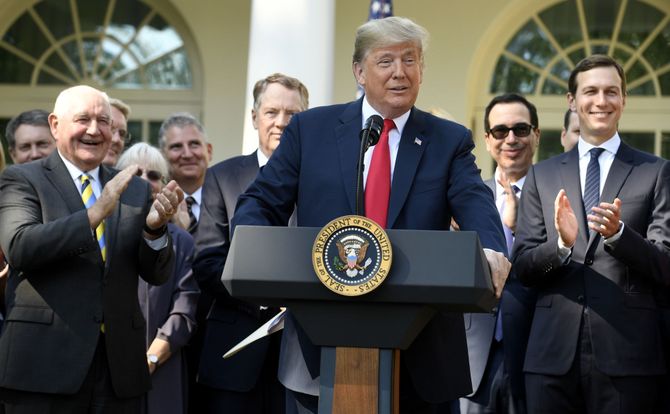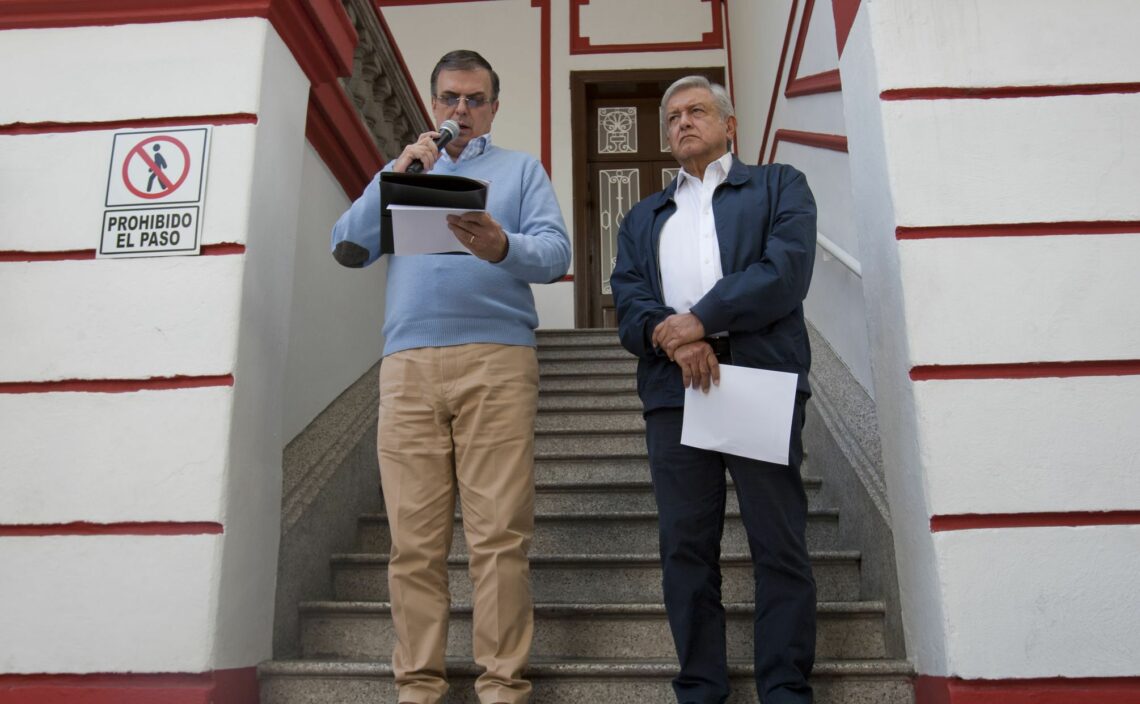The U.S. and Mexico go from pugilism to partnership
Despite confrontational rhetoric from the leaders of both countries, the U.S. and Mexico have plenty of reasons to maintain good relations. President Donald Trump and President-elect Andres Manuel Lopez Obrador have signaled a willingness to collaborate on priorities.

In a nutshell
- Donald Trump and AMLO have strongly criticized each other’s countries
- Yet both have strong incentives to work together, especially on trade and crime
- Cooperation between the two governments is likely to flourish in the near term
For decades, United States-Mexico relations have been a mixture of cooperation and confrontation. During his presidential campaign, Donald Trump harshly criticized Mexico on trade and immigration policy, but there was something of a rapprochement after his election. On the other hand, a fierce critic of U.S. policy, Andres Manuel Lopez Obrador (known by his initials as AMLO), won this year’s presidential election in Mexico and will take office on December 1. He promised to implement his own agenda, with less emphasis on the relationship with the U.S. But since then, despite their differences, both leaders have signaled their desire to work together. Some analysts predict that their contrasting priorities will make cooperation short-lived. Yet the prospects for expanding bilateral relations might be even more compelling.
Push and pull
Only China and Canada trade more with the U.S. than Mexico. Geography makes the two countries inevitable partners. In practice, routine cooperation between the two governments is continuous and ubiquitous, particularly on trade, counterterrorism and agriculture.
At the same time, there are frequent irritants to the relationship, including illegal migration, human trafficking and drug smuggling. In part, the popularity of President Trump’s call to “build a wall” reflects American frustration with the difficulties of managing the countries’ joint border. On the other side of the coin, Mexico blames the apparently insatiable American demand for illegal narcotics for fueling the transnational criminal networks that threaten its peace and stability.
High levels of corruption, violence and poor governance in Mexico impede cooperation with the U.S.
High levels of corruption, violence and poor governance in Mexico impede cooperation on a range of issues, from investment to tourism. In the Heritage Foundation Index of Economic Freedom for 2018, Mexico’s overall score is above regional and global averages, but the U.S. and Canada rank far higher. The disparity prevents the seamless integration of the Western Hemisphere’s major economies.
After the honeymoon
Still, there has been no shortage of encouraging statements pledging cooperation between Washington and the incoming Mexican administration. President Trump was quick to congratulate AMLO on his election victory. AMLO responded, “I send you affectionate hugs,” adding, “[w]e will put our voters and citizens at the center and displace the establishment.”
Many have predicted the cordiality will not last long. For example, Laura Carlsen, the director of the Americas Program at the Center for International Policy, wrote in Fortune:
The current coziness between Lopez Obrador and Trump, though, can’t last forever. Trump plays to an anti-immigrant, anti-Mexico base, and the Mexican population will never trust Trump or a Mexican president who appeases him. Clashes are inevitable between the state-primed economic revival and redistribution path Lopez Obrador has laid out and Trump’s America First strategy, motored by xenophobia and an expanding military-industrial complex.
These criticisms are based on the presumption that both will govern in a manner consistent with the populist platforms on which they campaigned. But there is plenty of evidence to suggest that their election rhetoric is more of a caricature of how they will govern than a reliable guide to how they intend to manage the bilateral relationship.

Make America great as Mexico rises
Two years into the Trump presidency, there is plenty of proof that the administration is anything but isolationist or xenophobic. Mexico is a case in point. Despite the public hostility between the two countries immediately after the election, behind the scenes, Washington and Mexico City worked well together. Recently, they successfully concluded negotiations over the U.S.-Mexico-Canada (USMCA) trade deal, a successor to the North American Free Trade Agreement (NAFTA).
Moreover, writes Ana Quintana, a senior Latin America policy analyst for the Heritage Foundation, “since the early days of the Trump administration, recalibrating the relationship with Mexico has been a priority for the White House.” Top officials across the administration have been involved in the effort, which has included participation of the Executive Office of the President (the group of agencies that support the work of the U.S. president) and Jared Kushner, Trump’s son-in-law and a key presidential advisor.
U.S. interest in cooperating with Mexico is based on several major priorities for the Trump administration. Topping the list is combating illegal migration, human trafficking and transnational criminal cartels. Second, despite the administration’s protectionist rhetoric, the White House views the new trade deal with Mexico and Canada as an economic engine that will help stimulate the economy by adding jobs and increasing wages. Third, the U.S. is deeply concerned about the growing influence of China in Latin America. Fourth, if Venezuela becomes a failed state, the U.S. and Mexico will have to work together on a regional response. Finally, the White House wants to stem the “opioid crisis,” fueled in part by a flood of drugs from across the southern border.
U.S. cooperation could help AMLO fulfill his sweeping promises to combat corruption and improve public safety.
For his part, AMLO has made sweeping promises to reform governance, combat corruption and improve public safety in Mexico. U.S. cooperation would greatly help him achieve these ambitious goals. For instance, he has vowed to shift more law enforcement responsibility from the military to the police, an effort that could be significantly advanced with American technical and logistical support. Likewise, the U.S. can provide resources to bolster AMLO’s planned anti-corruption campaign.
Radical policy shifts that would threaten Mexico’s macroeconomic stability are less likely, and the new government is expected to accept the recently negotiated trade deal. The U.S. and Mexico could well be reliable economic partners for years to come.
Sand in the gears
Though the incentives to work together are more significant than the populist rhetoric that divides the two leaders, hurdles to advancing regional cooperation remain. AMLO has long complained about the U.S. forcing Mexico to “do its dirty work” in terms of reducing illegal immigration from Central America and combating the drug cartels that serve the U.S. demand for illegal drugs. Furthermore, AMLO supports Mexico’s traditional policy of nonintervention. He would be a reluctant participant in initiatives to deal with either Chinese influence or state failure in Venezuela. U.S. proposals for cooperation will have to be crafted with these concerns in mind.
Government-to-government cooperation is likely to continue to flourish over the next two years.
Another potential sticking point is formal approval of the USMCA trade deal. Prospects for approval increased when the U.S. and Canada came to an agreement. The Mexicans updated the Canadians on their negotiations with the Americans and may have contributed to the successful outcome. The Trump administration hopes Congress will ratify the deal before the end of its session in December. If it fails to do so, prospects for ratification could hinge on the outcome of the November 2018 midterm elections and the makeup of the new Congress that will convene in January.
An additional challenge is the lack of a full diplomatic team. Washington has not appointed an ambassador to Mexico. The U.S. assistant secretary for Western Hemisphere Affairs has not been confirmed. AMLO’s team is reluctant to engage with Mr. Kushner, since he was a principal interlocutor with the outgoing administration of Enrique Pena Nieto.
Addition over subtraction
The most likely scenario is that government-to-government cooperation will continue to flourish over the next two years: both sides consider it a priority. Both sides also acknowledge the challenges in the relationship and are committed to addressing them. The passage of the USMCA trade agreement is likely if President Trump’s Republican party maintains control of Congress. Moreover, the U.S. and Mexico will probably agree on a new comprehensive package of American assistance to address corruption and public safety issues.







